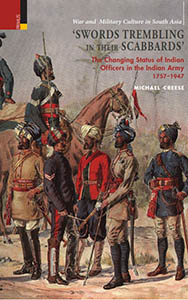
Swords Trembling in their Scabbards: The Changing Status of Indian Officers in the Indian Army, 1757-1947
AUTHOR- Michael Creese
| HB ₹995 |
||
INFORMATION
- AUTHOR : Michael Creese
- HB ISBN : 978-93-86552-27-3
- Year : 2017
- Extent: 228 pp.
- Discount available on checkout
- Usually dispatched within 3 to 5 working days.
‘Swords Trembling in their Scabbards’
‘The Changing Status of Indian Officers in the Indian Army, 1757-1947’
| HB ₹ 995 . $ . ₤ |
||
INFORMATION
- AUTHOR – Michael Creese
- ISBN – 978-93-86552-27-3
- Year – 2017
- Extent: 400 + 40 coloured illustrations
- 10% discount + free shipping
- Usually dispatched within 3 to 5 working days.
The Indian Army founded by the East India Company in the eighteenth century was unique among the armies of the world in that it had two groups of officers – British and Indian. The intention was that the Indian officers, coming from similar backgrounds as their men and naturally understanding their social and religious mores and customs, would form the crucial link between the British officers and the sepoy. It is surprising, therefore, that there has been very little written, by either British od Indian historians, regarding the role and experience of those offices. They were promoted from the ranks and served for many years in their units, embodying both the spirit and the traditions of their regiments. So, who were these Indian Officers who look out at us from photographs taken from the eighteen eighties onwards? How did they, and their British officers, interpret their role? The present volume is a long overdue attempt to answer these questions and to pay due tribute to the men who served the Raj and their country so well in peace and war.
Michael Creese is a Retired Headteacher and an Educational Consultant.
The Indian Army founded by the East India Company in the eighteenth century was unique among the armies of the world in that it had two groups of officers – British and Indian. The intention was that the Indian officers, coming from similar backgrounds as their men and naturally understanding their social and religious mores and customs, would form the crucial link between the British officers and the sepoy. It is surprising, therefore, that there has been very little written, by either British od Indian historians, regarding the role and experience of those offices. They were promoted from the ranks and served for many years in their units, embodying both the spirit and the traditions of their regiments. So, who were these Indian Officers who look out at us from photographs taken from the eighteen eighties onwards? How did they, and their British officers, interpret their role? The present volume is a long overdue attempt to answer these questions and to pay due tribute to the men who served the Raj and their country so well in peace and war.
Michael Creese is a Retired Headteacher and an Educational Consultant.




